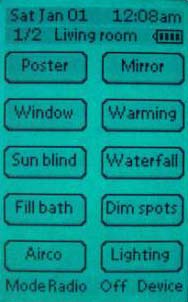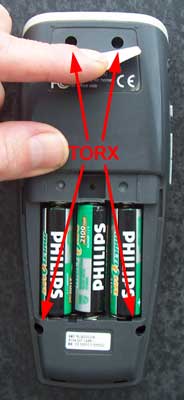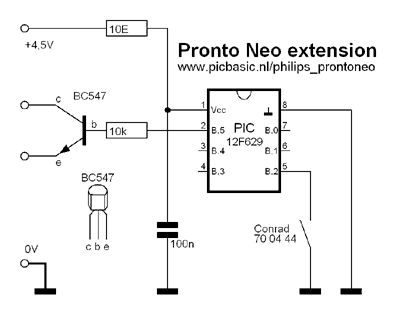

For the remote controlled projects from this site you can ofcourse use your normal TV-remote or
build the remote control (exact like you wish) from this site.
Annoying is that you have to bear in mind which button steers which part (1 = lighting, 2 = window, etc.).
A solution for this problem is a remote control from the Philips Pronto Neo serie,
like the SBC RU930 *).
You can design the touch screen on your PC and download logo's and symbols from
internet from several sites.
You can also download RC5/RC6 codes, but there is a learn mode too,
so that this remote can learn all your other remotes (even if it's not a RC5/RC6 protocol) and replace them.
I've made a 'Living room' menu with (simple, rectangle) buttons.
In combination with the wireless 10-channel receiver project can I via
the remote control open and close the sunblind and windows, dim and switch lighting groups,
arrange the central heating, switch a small waterfall, etc.
I can fill the bath also, when I push on that button the Pronto Neo jumps to a numerical pad screen
where I have to put in a code first, so that nobody can fill the bath accidently.
In place of remember the numbers from the remote control (1 = lighting, 2 = window, etc.)
you can place the text on the touch screen from the Pronto Neo remote control.
(See screenshot Pronto Neo RU930 underneath)
 |
More info:
|
||
| Screenshot from menu Living room |
TIP
To learn the Pronto Neo unique codes, you can build the universal remote control
from this site and send the codes to the Pronto Neo or any other programmable remote.
Some devices do have more functions on board then there are buttons on the with that device delivered remote control.
By sending all the RC5 or RC6 command codes one by one you maybe discover some hidden functions on your CD player or which device you trying at.
*) In America typeno: Philips TSU500
 Tiltswitch Conrad 70 04 44 |
Normaly sleeps the Pronto Neo and wakes up when a key is pressed or the touchscreen is touched.
Also pressing the backlightswitch wakes the Pronto Neo, wíth backlight ofcourse.
This project will use this switch.
With building a tiltswitch from Conrad and a PIC12F629 steering in the Pronto Neo wakes up the Pronto Neo wíth backlight when the Pronto Neo is picked up.
The tiltswitch is almost placed horizontal in the device so that a slight movement from the Pronto Neo, contact is made or broken.
Connecting the tiltswitch directly over the backlightswitch will not work because when the Pronto Neo is held in a position that the tiltswitch makes continue contact,
the Pronto Neo will not operate.
The PIC now gives here only a short pulse (one shot) to the backlightswitch, undepending if the tiltswitch stays making contact or not.
Feeding from the PIC comes from the recharcheable batteries from the Pronto Neo (3 × 1.2V).
The PIC sleeps normaly, to saves the batteries.
The program in the PIC waits for an interrupt from GPIO.2, whereto the tiltswitch is connected.
When the tiltswitch makes contact (by movement),
the PIC wakes up and gives directly via a BC547 a pulse to the tiltswitch from the Pronto Neo, which also will wake up wíth backlight.
The PIC wakes up for minimal 30 seconds, and every time the tiltswitch moves, this time is set back to 30 secondes, without giving a pulse to the Pronto Neo.
Until the Pronto Neo and thus also the PIC is not moved for 30 seconds, the PIC falls in sleep again.
8$

The circuit is hanging in the Pronto Neo.
Place the mouse over the picture for a detailphoto.
 Torx-screws are placed behind the batterielid and under the sticker. |

The tiltswitch is placed under the PIC 12F629.
The project hereabove is knocked together very quickly.
If you have a SMD version from the 12F629, or even better a 6-pins 10F200 SMD, then ofcourse is thát a better way to build this.

The collector and emitter from the BC547 transistor is connected
over the backlightswitch from the Pronto Neo (see pictures above).
Look for the PIC Basic programlisting to the Dutch part from the Pronto Neo.